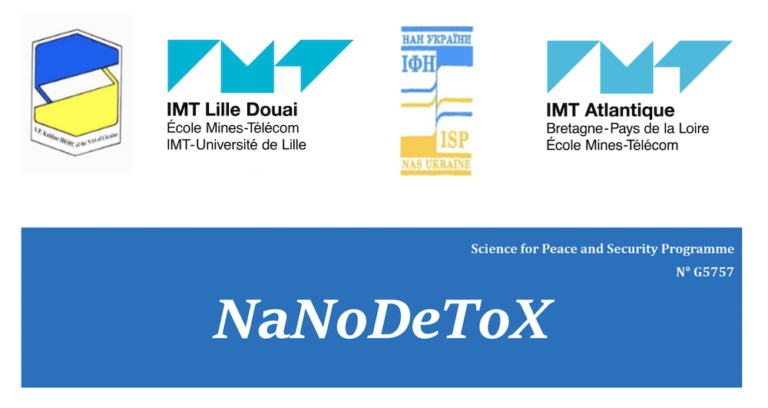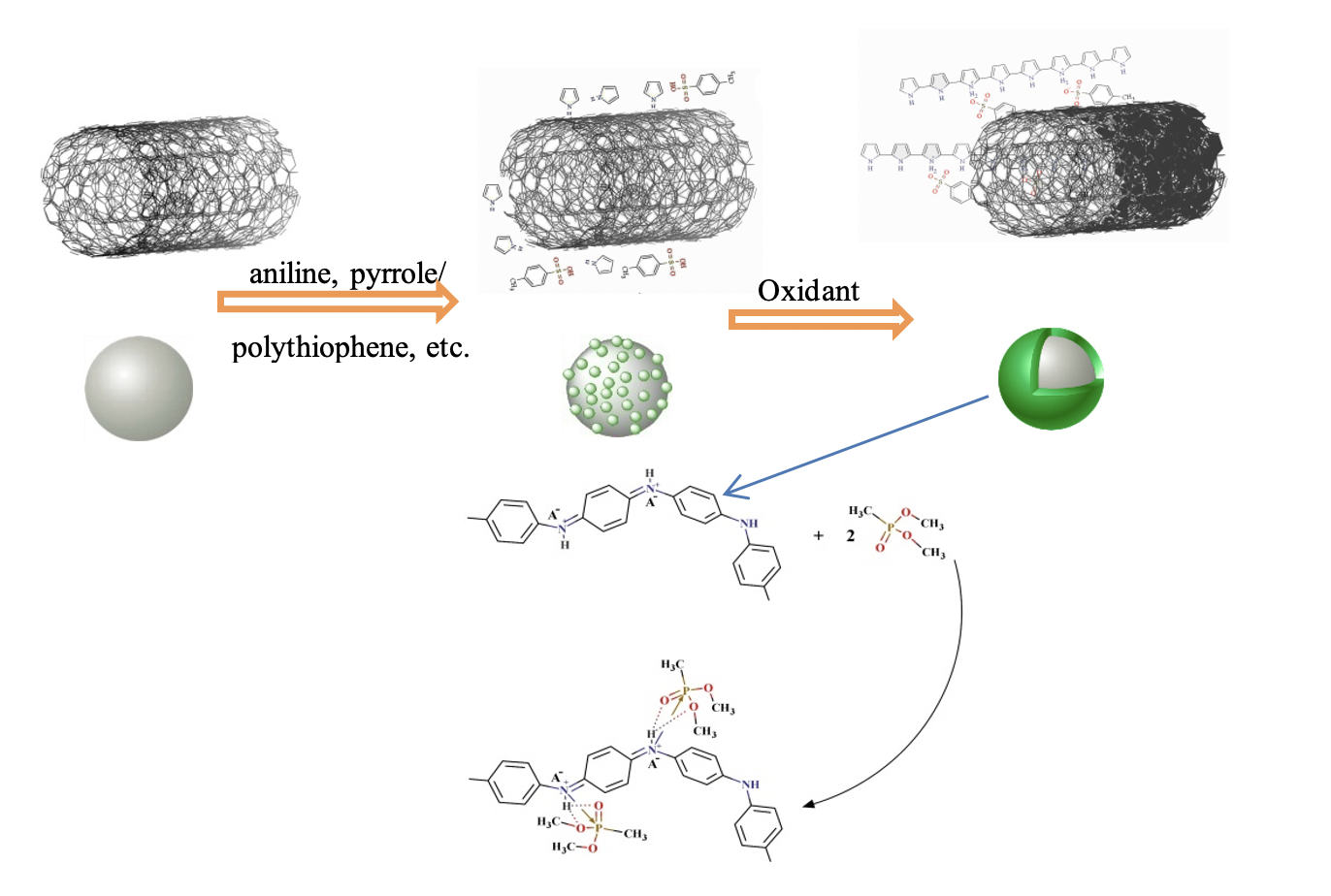
Smart nanomaterials and a soldier alarm badge to detect toxic gases by mobile devices
Project G5757 supported by the NATO Science for Peace and Security Programme : http://www.nato.int/science
Abstract
The project is dedicated to creation of the new smart wearable soldier alarm badge to detect toxic gases. The project develops new functionalized smart nanomaterials based on conducting nanocomposites and liquid crystals to detect nerve agent mimics. They will be integrated as array on the new sensor card installed in the developed smart badge. Electronics and recognition algorithms will be developed for signal treatment and data processing. In case of the chemical attack (ppb concentration) the badge will give fast sound and digital alarm, transmit it via wireless connection to soldiers/first responders and remote command post for precise analysis.
1. Objectives of the project
Recent terrible chemical attacks of civilian people with nerve agent sarin in Syria (Ghouta area and Khan Shaykhun, 2013 and 2017) and in Great Britain (Skripal’s case, in Salisbury and Amesbury, 2018) clearly prove that currently any soldier, official or other person can be poisoned anywhere and, therefore, are not safe even in a seemingly peaceful place. The problem of chemical safety of the population is critical for sustainable development. This problem can be significantly mitigated due to a rapid reaction even in the case of a suspicion or expectation of an appearance of toxic substances in the environment. Such reaction, in turn, can be realized through providing these people with alarm and analyzing sensor devices, among which wearable light-weight sensor devices with long operation life would be probably most convenient and effective especially in the case of their ability to transmit alarm information to soldiers / first responders / commander/ remote analytical centers. However, there are currently no such devices unifying all these important options on the market.

Figure 1. Chemical attacks examples: a) The victims of the Ghouta, Syria attack in August 21, 2013; b) Investigators in Salisbury, England, March 2018 after Skripal and his daughter were poisoned. (NYT, by A. Schaverien, 15 Aug, 2019)
In order to respond to this challenge our project has two main objectives:
The first objective is to develop the new smart wearable light-weight soldier alarm badge which is able to detect the toxic gases (nerve agents) simultaneously in alarming sound and digital modes. Miniaturized electronics for the badge with recognition algorithms will be also developed for signal treatment and data processing. In case of chemical attack the badge will give sound and digital alarm and transmit it via Wi-Fi/Bluetooth protocols to soldiers/first responders/commander.
The second objective is to develop, synthesize and study such critically important components of this badge as new smart nanomaterials (conducting nanocomposites and liquid crystals) which are able to reversibly change their electrophysical properties in the presence of the nerve agents mimics in low concentration range. Due to different mechanisms of sensor responses of these nanomaterials, selectivity of sensor arrays (installed in the badge) to the toxic gases will be improved. Sensitivity of the synthesized nanomaterials will be additionally enhanced by ionic additives.
Accordingly, the main expected outcomes of the project will be:
- New smart nanomaterials for sensitive, selective and reversible sensing of nerve agents and their simulants.
- Soldier self-powered lightweight alarm wearable electronic badge for fast signalling to the toxic gases in air.
Working for these main outcomes we expect to reach also the next outcomes:
- Reliability of the toxic gases detection due to using different physical converters (resistive, impedance).
- Wireless connection of soldier badges will facilitate fast alarm communicating between soldiers/first responders.
- Gas absorbing storage-concentrator in the badge unit facilitating precise analysis of the toxic gases in remote analytical centers to identify their nature and origin.
- Express analysis of the composition of the toxic gas mixture by multivariate (statistical) analysis of data from the sensor array in a remote command center.
- Original algorithms for automated recognition will facilitate determination of the type of the toxic analyte.
All of these approaches integrated into a single deviсe, will substantially improve the efficiency of early timely poison warning and increase safety of NATO forces in case of chemical attack.
The developed smart nanomaterials and advanced alarm badge might be used in case of suspected or real chemical hazards and attacks by different NATO sectors, in particular, by the newly formed joint Chemical, Biological, Radiological and Nuclear Defence Centre of Excellence (JCBRN Defence COE) to prevent poisoning of soldiers and to save their lives. Naturally, these project developments can be expanded to first responders / civilians.
The main advantages of these novel smart nanocomposites and light wearable badges are their easy and fast (few seconds) alarm capability to inform, both by sound and wireless connection, a soldier or group of soldiers and commander around and in remote places of the presence of toxic gas(es) and their alleged class, durability, repeatability of sensor responses with low detection limit (10 ppb). A distinctive feature of the developed badge will be the possibility of its repeated use. Use of gas absorbing storage-concentrator unit will facilitate precise analysis of the toxic gases in remote analytical centers to identify their nature and origin.

Figure 2. Schemes of chemical synthesis of conducting polymers composites with carbon nanotubes and nanoparticles (upper) and their sensing interaction with DMMP
2. Contact information
Professor
Jean-Luc WojkiewiczInstitut Mines Telecom Lille Douai
Energy and Environment Research Center
France
NPD*
Jean-luc.wojkiewicz@imt-lille-douai
Professor
Alexander (Oleksandr) PudV.P. Kukhar Institute of Bioorganic Chemistry and Petrochemistry of NAS of Ukraine
Ukraine
PPD**
Alexander.pud@gmail.com
Dr.
Cyril LahuecInsitut Mines Telecom Atlantique
Dept Electronics
France
Co-director
Cyril.lahuec@imt-atlantique.fr
DrSc
Oleksandr KuklaV.E. Laryov Institute of Semiconductor Physics, NAS of Ukraine
Ukraine
Co-director
Alex.le.kukla@gmail.com
*NPD : NATO country Project Director
**PPD : Partner country Project Director
3. Link of the institutions

